Stone’s Throw Investigation: Urgent Need to Address Maintenance Lapses at Croton Point
Investigative / Enterprise In-depth examination of a single subject requiring extensive research and resources.
Opinion Advocates for ideas and draws conclusions based on the author/producer’s interpretation of facts and data.
This piece is the first installment in a new Stone’s Throw series about issues impacting our local environment.
Environmentalists Decry Ecological ‘Neglect’ at Park; County Says Grasslands to be Tended
By Adam Stone

Like so many people navigating 2020 pandemic life, local couple Joseph Wallace and Sharon AvRutick sought solace in nature.
They found that oasis at Croton Point Park, which sprawls across a vast 508 acres, nestled on a peninsula along the serene eastern shore of the Hudson River.
The thriving grasslands at the county park had become a haven for endangered butterflies, bees, birds, and other pollinators, and was nothing short of a visual and spiritual feast, with its waving green, yellow, and purple grasses.
Beauty aside, the site also fulfills a crucial ecological role for our local world.
With its gorgeous panoramas of the river, Croton bay, and the surrounding landscape, the former Pleasantville residents were wowed by the magnificence.
“I just couldn’t believe this beautiful, pure place,” Wallace recalled wistfully in our phone interview last week. (AvRutick and Wallace visit the park almost daily).
But There’s a But…
But by last summer, Wallace said, grassland upkeep began to stall. Although Croton Point Park had previously and rightfully been hailed as an environmental triumph, a dreary chapter in the story had begun, a new narrative he says has been marked by abandonment and inattention.
“They are not being maintained and are dying as a result of this willful neglect on the part of state and local officials,” said Wallace, who characterized the disregard as an “ecological scandal.”
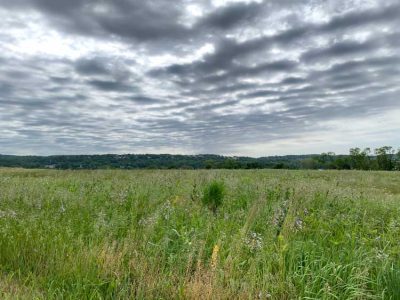
“Every day, their environment degrades, invasive plants kill off the invaluable native grasses, and the endangered birds and other creatures flee,” the Croton resident also lamented. “Local experts say that without critical maintenance, within just a few years the hill will revert to the wasteland it was, the $600,000 wasted.”
Wallace is referring to an at least $630,000 investment of state and county funds to transform the former Superfund site into a rare and stunning native grassland — a Superfund is a contaminated location designated by the U.S. government as heavily polluted and requiring extensive environmental cleanup. (Some sources tell me more than $800,000 was ultimately spent).
A significant portion of the park grounds previously served as a Westchester landfill, from 1927 to 1986, but the contaminated area was capped and revitalized as green space in subsequent years.
“But what was up there instead on that hill was just basically a big sort of empty, raggedy field,” explained Wallace, who moved to Croton in May of 2019 after 32 years in Pleasantville. “In other words, it was going to be the way a lot of untended fields are now, it was going to be vines, poison ivy and mugwort and all this stuff, which is almost entirely not native and not conducive to animal and bird life.”
However, back in 2016, then-Sen. Terrence Murphy (R-Yorktown) secured a half million of state funds, the lion’s share of the $630,000 to $800,000-plus total investment toward addressing restoration issues along the more than 100 acres of meadowland.
“This 100 acres needed a little bit of help,” trumpeted Murphy at a July 25 of 2016 news conference.
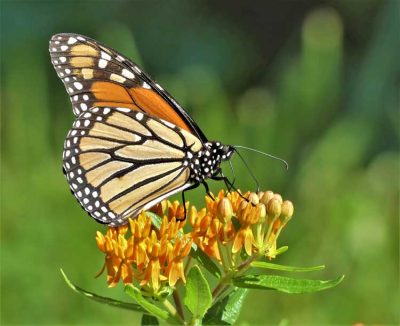
By 2019, work began to add native plants and improve bird habitat on the landfill.
Yet now Croton Point Park is again heading in the wrong direction, a half dozen deeply-involved local environmentalists told me, despite years of work and many hundreds of thousands of dollars spent to achieve such a laborious but monumental success.
(In the process of this reporting, county officials revealed to me how $40,000 in funding to address some of the issues cited here by local environmentalists had just been approved; I’ll get to that in a bit).
Wallace said previous end zone dancing by local officials about the success at Croton Point Park displays a misunderstanding of the issue.
“So you can’t claim victory over something like this and then not put any money into maintaining it,” Wallace told me. “You just can’t.”
Saw Mill River Audubon
Wallace is a major volunteer player within the Saw Mill River Audubon, a local organization that administers seven preserves in Westchester, and also runs programs and camps.
Saw Mill River Audubon was also heavily involved with the grassland restoration at Croton Point, as well as subsequent management, such as careful mowing, spot spraying, and surveys of rare wildlife.
“Grasslands have to be maintained,” Saw Mill River Audubon Executive Director Anne Swaim emphasized to me in a phone interview last week. “They won’t naturally stay as grasslands. They’ll succeed into shrubs, into shrub land, and into forest.”
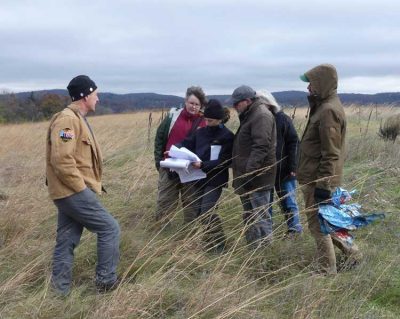
If native grasslands suffer from neglect, the delicate ecosystem they support becomes endangered.
I asked Swaim to detail the potential implications.
“Loss of species diversity and plant diversity,” she explained. “And whenever you lose a species, you don’t know what it was connected to. It’s not just grassland, it’s the adjacent habitats too, because it’s that web. And so when we start losing pieces of it, plants or animals due to loss of habitat, we don’t know what else is going to come next. Everything’s connected to something else.”
And how could that directly impact humans?
“I mean, people have made the argument that the reason we have so many ticks and Lyme disease is because of the deer population out of control,” Swaim replied. “There’s no predators for whitetail deer, so things like that spill over because we live within natural systems and if they’re not healthy and balanced, things get out of control and they can ricochet right at us.”
Mother Nature
Over the past year or so in particular, Mother Nature began to react to the reported neglect.
Invasive species started to spread. Swaim pointed specifically to a plant called spurge.
“They weren’t completely removed, unfortunately,” Swaim said. “And now they’re spreading and they’ll just take over, which will be too bad because it was a lot of money and time spent to try to restore it. It’s an important habitat.”
Wallace stressed the urgency of the matter. Without immediate intervention, the park’s rejuvenated landscape could rapidly revert to its former state, rendering the initial investment futile, he stressed.
“It’s not only a classic example of the sooner the better, but if they could start it this fall, start that work this fall, I think it would get an enormous jumpstart on getting it back under control,” Wallace said. (Bear with me, I promise to get to what the county told me about its new September plans in a minute).
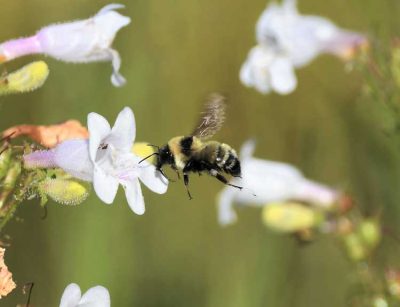
The county did prepare a grassland maintenance and management plan last summer, and the document, dated July 1, provides recommendations for annual mowing, monitoring, and spot herbicide treatment of invasive weed species in the restored native grassland at Croton Point Park.
But, Swaim said, “we cannot find evidence that it has been implemented nor can we obtain confirmation that it has been funded” while separately acknowledging how “we did get the mowing right this year.”
As much as she appreciates all of the wonderful programming and activities facilitated through the County Parks department, Swaim bemoaned how there’s “zero mechanisms to share their long range plans with the public or invite public comment.” (Croton Point Park is probably most widely known for hosting prominent annual events, such as EagleFest and the famous Clearwater Festival).
Swaim and Wallace also described a lack of transparency and responsiveness by local officials.
Wallace didn’t keep a full record of his outreach but said he contacted the county through an online form about a year ago, and also emailed county and state officials about six to eight months ago after observing conditions continue to deteriorate.
(A message Wallace tried to send last month, on July 14, was sent in error to non-existent county email addresses).
County Executive George Latimer, and Westchester Parks Commissioner Kathy O’Connor, for their parts, declined my interview requests.
“I have to talk with relevant individuals to assess the situation before I can give you an intelligent response,” Latimer told me of his decision in an email.
But Latimer’s spokesperson, Catherine Cioffi, emphasized how my interview request marked the first time she learned about the concerns, and how the county executive’s office is now working to get up to speed on the related issues.
Meta Moment
There was also a meta reporting moment on Friday when Latimer included me on an unsolicited email to Wallace and a long string of officials, pointing out how the activist’s email message from last month (which I’d shown Cioffi) was sent to faulty addresses.
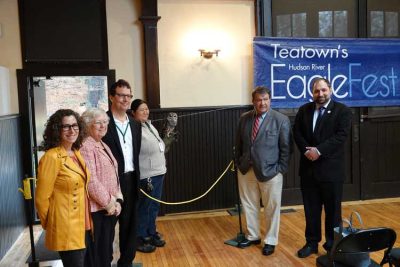
“It’s also undeniable that others have reached out repeatedly to park administration and other officials on this issue, receiving either a dismissive response or none at all,” Wallace assertively replied to Latimer, also including me in the exchange.
“Meanwhile,” he also said, “the degradation of the grassland continues, making it more and more likely that the $630,000 will have been wasted, and the place will again become as barren as it was before the restoration began.”
Latimer then extended an olive branch, and the offer of a meeting with the county.
“Whether or not it was your first attempt, it is my first exposure to your concerns and we will take them seriously and urgently,” Latimer wrote. “As I accept your position of advocacy, you can accept my offer of attention to that advocacy.”
Wallace accepted.
Now in touch with Latimer’s senior staff, Wallace did say how he rejects the idea that government officials can reasonably cite his errant email from last month as a legitimate excuse, stressing how proactive attention is required.
“July was the hottest month ever recorded worldwide,” he said. “Our oceans are boiling. Rampant wildfires in Canada fill our air with toxic fumes. In these dark, frightening times, is it too much to ask that our state and county officials do everything in their power to preserve a rare environmental success story — and the precious, threatened birds, butterflies, and plants that depend on it?”
‘Very Important Conversation’
Setting aside the communication issues, Cioffi said how the county executive’s office now plans to investigate the matter further.
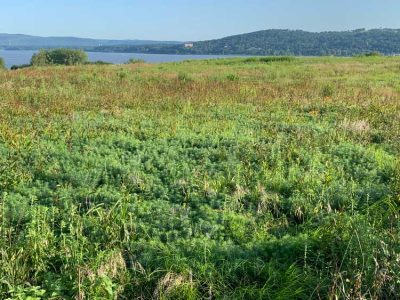
“So, again, I think this is the start of a very important conversation and I’m glad that we’ve initiated it and I think there’s just more to come,” she stated.
I asked specifically about whether a dedicated stewardship team for county parks could help solve the problem.
Should the county hire a few workers to tend to vital maintenance?
“I think at this point we are open to having a discussion with the people that are concerned about the location, and after that discussion, we can make a better decision,” Cioffi replied.
Wallace said he’d also tried to alert Sen. Peter Harckham (D-South Salem) about the issues.
But the senator’s office noted to me how the matter should be primarily handled by county officials, given the fact that Croton Point is a county park.
“One of the things that we can talk about is that [Senator Harckham] has got $2.1 million of state grants coming in for municipalities to embark on electrification programs like charging stations and solar arrays,” the legislator’s spokesperson, Tom Staudter, told me in a phone interview last week. “So, I mean, there’s a lot of different things going on that we can kind of keep our finger on and help out. But for instance, if the county came to us and said, ‘Wow, we could use more state support in maintaining something that came into being through state money,’ that would be great.”
I did ask Staudter whether the senator could have more proactively addressed the substance of the maintenance issue within the context of the half a million dollars of state funds that Murphy (Harckham’s predecessor) had secured in 2016 for the restoration.
“We don’t have any control over what the county does,” Staudter replied. “It’s home rule. We can’t sit there and say, ‘You know what, we’re going to give you $400,000 and we want you to fix up this part of the park.’”
But Staudter did say he would be immediately contacting the county to investigate.
‘Scandalous Truth’
In addition to the lack of responsiveness to their personal advocacy, Wallace and Swaim also criticized the county’s refusal to maintain a more public system when it comes to park management dialogue.
“The officials’ unwillingness to engage with us points to a deeper, even more scandalous truth: Westchester County’s policy of making park-management decisions without the benefit of public hearings or outside comments of any kind,” Wallace stated to me in an email before our phone interview.
Wallace and Swaim both stressed how other counties (such as the demographically-similar Fairfax in Virginia) make decisions very publicly.
For instance, the Fairfax Park Authority regularly publishes reports and documentation to keep residents informed while also engaging in public discussions about future plans.
“So why does Westchester County keep its process secret?” Wallace asked.
In a similar vein, Swaim said the Westchester County Parks online presence is sorely lacking.
“Look for something about public input and you’ll end up in a weird page about this committee they have that never publishes its meetings or its minutes and is a rubber stamp,” she said.
Westchester County Parks, Recreation and Conservation Program Administrator for Sales and Marketing Laurie Sage did not respond to my requests for more information on the department’s protocol for public information and public engagement.
But Cioffi defended the county’s record on keeping taxpayers informed.
“I mean, I think we have a pretty robust public engagement process,” she said. “I think we are very transparent.”
I did wonder why the passionate environmentalists couldn’t have easy access to the fact that the County Parks department had already sought and secured funding, or the fact that maintenance work is being planned for this fall.
“Every capital project is voted on by the board of legislature,” County Parks First Deputy Commissioner Peter Tartaglia replied to that question, during a conference call interview with him and Cioffi. “There’s a whole process. So there’s tons of paperwork that goes on all the time. There’s a ton of transparency. Is there transparency in every minute little piece? No. But if somebody asks, we’re happy to [share].”
‘Political Black Box’
Swaim expressed especial disappointment in Latimer. She said she participated in a Zoom with the county executive a few years ago, and told him about the example from Fairfax County.
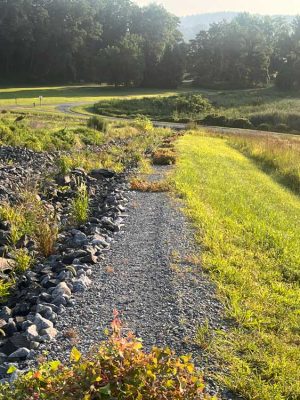
“Nothing changed,” Swaim said. “So maybe I shouldn’t be as kind to Latimer as I’m trying to be because I like him for a lot of things, but this just doesn’t budge.”
I asked Swaim why she believes Latimer’s office might not be as responsive to the issue as she hoped. Latimer, a Democrat, values his achievements in open government, responsiveness, and his very real record on the environment, one of his policy priorities.
“We challenged George Latimer when he started his term because he was all about transparency,” Swaim replied. “We sent another letter to him on his second term and said, ‘Hey, things haven’t changed.’ I guess it’s some kind of political black box. That’s our only guess.”
(Cioffi balked on this point: “[Anne] brought this up a couple years ago and we pointed her to the website where she could read about the capital projects and other projects happening in the county,” the Latimer spokesperson countered).
Swaim also said the failure to address ongoing maintenance appears to be something of a pattern. There will be initial excitement among local officials, and the requisite back-slapping, but then a lack of post-hoopla followthrough.
“Parks did this big restoration along Bronx River Sound Shore, and then it wasn’t maintained,” Swaim said. “And it’s gone all back to invasives. It seems like there’s a lot of fluff for a project, but then they’re not maintained.”
Swaim speculated that certain aspects of the project’s oversight lapses might be the result of a personnel change.
“It was administered through the Department of Planning from a guy who’s not there now,” she said. “So part of the problem is that there’s not really somebody that’s following the project anymore.”
Wallace also encapsulated the resulting problem succinctly: “Invasives invade for a simple reason: They’re good at taking over. You can’t just hope they’ll go away.”
The initial planning and installation of the Croton Point Park grasslands restoration project was done by Larry Weiner Landscape Associates, an acclaimed landscape expert here in the eastern portion of the United States.
My requests to speak to a representative from the firm were not granted.
Out Like a Lamb
I also connected last week with Karalyn Lamb, a longtime volunteer at Croton Point Park. Lamb has been involved with the grassland project for about the past decade, working with Saw Mill River Audubon.
Despite the initial restoration efforts, Lamb said the lack of post-project management has led to the resurgence of the invasive plants, threatening the delicate habitat that supports imperiled species such as monarch butterflies and golden northern bumblebees.
The invasive plants are recolonizing — plants that insects can’t eat, she explained.
“So since insects are the foundation of terrestrial food webs, the food web is being compromised,” said Lamb, who also serves on the steering committee of the Native Plant Center in Valhalla while also working as a board member of Pollinator Pathway Northeast. “If the food web is compromised on the landfill, it means that the imperiled grassland birds that use that as a habitat don’t have as much food.”
Raised in Croton herself, Lamb was thrilled to see the landfill capped and seeded in 1995, and the subsequent efforts to restore the grassland. Restoration work proved successful in eliminating invasive species and creating an important grassland bird habitat, she said.
But now, Lamb noted, a particular concern is the declining population of monarch butterflies, which are known to use the milkweed on the landfill as a host plant.
This…Is…Jeopardy!
The invasive plants are overtaking this essential milkweed, jeopardizing the habitat that supports these at-risk butterflies, Lamb also said.
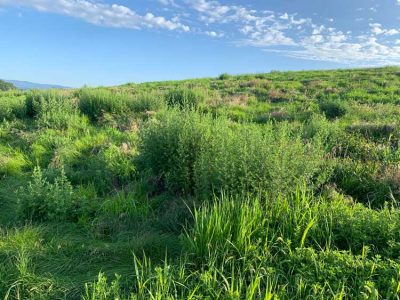
Similarly, the golden northern bumblebee population is facing rapid decline, with the landfill being one of their last remaining habitats. The loss of their vital foraging plants due to invasive species further exacerbates their vulnerability, Lamb observed.
“I think the county needs to put money in the budget for expertise and professional invasive plant management,” she said. “I think the first step is to get an assessment from a qualified meadow management expert…I think if you had someone with expertise in these situations, they would be able to recommend some practical steps.”
Lamb pointed to the recently-released four-year status assessment by the New York Natural Heritage Program, the first of its kind in the state, which found that 38 percent of New York’s native pollinators are at risk of extirpation, with a worst-case scenario suggesting up to 60 percent of the native insect pollinator being at risk.
Regarding bumblebees specifically, Lamb said the “compromise to the habitat on the landfill is just like one more nail in the coffin.”
“It’s a beautiful bumblebee and it’s one less chain in the link of biodiversity and who knows what some of these species do to benefit us, right?” she said. “I mean, bumblebees are very important crop pollinators and pollinators of wild plant species. So these bumblebees are pollinating wild plants on the landfill and allowing them to set seed and proliferate further so that’s their value up there is that they’re pollinating the native plants that we want to proliferate.”
So what’s the bottomline?
“If left unchecked, the invasive plants in the landfill grasslands have the potential to negatively affect habitat for at-risk pollinators (like golden northern bumblebees and monarch butterflies) by outcompeting the more beneficial native forage plants,” Lamb stated in an email after our phone interview.
The ‘Taro’ Card
OK, finally, let’s get to the aforementioned department response. There are undoubtedly leaders within County Parks seeking to address the issues.
Taro Ietaka, the department’s conservation supervisor, said in our phone interview last week that the funding to address the issues is “developing now.”
He said approval came about a week before our interview, secured through the Soil and Water Conservation District, which authorized $40,000 in funding specifically for the grassland restoration project.
The plan is to conduct a survey next month to assess the invasive species and establish the priority areas for treatment and potential reseeding, Ietaka told me.
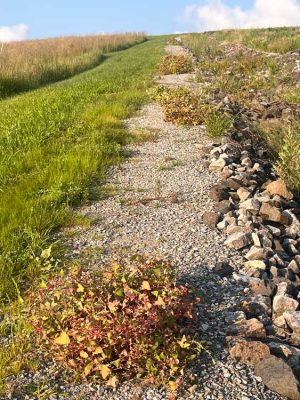
Subsequently, the implementation of any treatment would require approval from the department’s pesticide committee, with a projected planting timeline of 2024, accounting for the necessary contract and bid processes, he also said.
“We’ll be evaluating again which invasives are going to be the main target,” Ietaka remarked. “And also if reseeding is required, if there’s reseeding or replanting that would be needed, our hope is to use locally collected seed and propagated plants from Hilltop Hanover Farm. That’s the hope.”
Due at least to the lack of a more public process, the deeply engaged, information-starved activists I spoke to were not previously aware of these details.
Advocrat
If you’re both a passionate advocate and a bureaucrat — some call it an advocrat — you’re forced to walk a fine line between pushing for better policy while executing on existing policy. But there’s also time management and prioritization to consider.
“As that goes, I think just keeping it in people’s ears, there’s so much happening within the county,” Ietaka replied when I asked him about any push he might have made internally for more funding. “So the Parks Department alone manages 18,000 acres, of which this grassland restoration is about 100. So it’s important to keep it in people’s minds. And again, that’s what the advocates are doing and that’s fantastic. We need people like them.”
Ietaka also emphasized how this work has always come with serious challenges.
After capping the landfill, initial attempts to seed the area with desired species failed, and the grassland was soon overtaken by invasive plants.
The Parks Department, along with the Department of Environmental Facilities and the Department of Planning, has been involved in managing and overseeing the restoration project, which involves a two-year mowing plan to suppress woody growth and invasive species.
“We are absolutely trying our best and we expect to make some progress soon,” Ietaka said.
‘Tireless Advocates’
I asked Ietaka what he thought about the critique from area environmentalists about the failure to address maintenance issues, and the treatment of invasive species.
“So [Saw Mill River] Audubon has been very valuable and they’re tireless advocates, so we appreciate it and we can always do more and they’re always pushing us to do more,” he replied.
Ietaka noted how after the initial installation, multiple seedings of desirable plants were carried out, along with treatments to control invasives.
He said recent surveys conducted by the conservation division indicated the presence of both invasives and desirable plants, prompting the development of a plan to prioritize invasives for treatment and potential reseeding in September.
“So that’s still in the planning stages,” he said. “We’re going to…come up with a plan of which invasives are going to be the most detrimental and most likely to spread versus [and] which ones we can tolerate at low numbers.”
Despite securing the $40,000, the actual impact of the funding, and whether it’s enough, will depend on the evaluation of bids and quotes from applicants, Ietaka explained.
“More funds [are] always better. Well, not always better, but definitely we could get more done with more funding,” he said.
Survey Says
Ietaka also mentioned how the management plan includes a mowing regime for controlling invasive plants, prompt seeding and planting of desirable species after removal of invasives, and continuous surveying to address new invasive arrivals.
Species are prioritized based on their impact, with potentially lethal species like black swallow wart receiving high priority, while less detrimental species like those in the clover family are considered lower priority.
“We’re working on it, and we have devoted staff time again for surveying,” Ietaka said. “So we are absolutely trying our best, and we expect to make some progress soon. Now with this additional funding and sort of the will and the renewed focus, we’re going to make some really good progress.”
Off the record officials (not Ietaka!) from the county told me how Croton Point Park, with its landfill history, still emits methane, which presents certain constraints on vegetation management and complications with Department of Environmental Conservation involvement.
But Democratic Westchester Legislator Catherine Borgia, Croton’s representative on the County Board, said the methane issue cited by some sources is not a significant factor, as far as she’s aware.
“It’s almost completely nothing at this point,” she said. “We actually looked into this is several years ago now, whether we could capture that as an energy source, but it had been so dissipated that it wasn’t worthwhile at that particular park.”
In fact, when I checked with the New York State Department of Environmental Conservation (DEC) directly, a spokesperson seemed to push back on the general notion advanced by the county.
While noting that Croton Point Park — the former Croton Point Landfill — possesses 113 gas extraction wells that encompass the gas collection system, the DEC told me how “upkeep and maintenance of this system is the sole responsibility of Westchester County.”
“The county is required to notify DEC if the system is compromised or needs repair,” a DEC spokesperson told me. “To date, DEC has not received such notification.”
To give the bureaucratese-to-plain-English dictionary translation, the agency appears to reject any possible conclusion by the county that DEC involvement is significantly to blame for stalled maintenance.
The DEC also said how it oversees the review of annual groundwater and leachate sampling results collected at Croton Point Park.
Tartaglia, the county parks deputy commissioner, did observe how Croton Point management remains bureaucratically complicated.
“It was a landfill,” Tartaglia noted. “So the Department of Environmental Facilities is heavily involved in its maintenance because it still emits methane from it, which it will for years to come. So they are responsible for certain maintenance aspects of that landfill. Then the Parks Department is responsible for certain aspects of it. Then it was a Planning Department project for the restoration.”
Birdman of Ossining
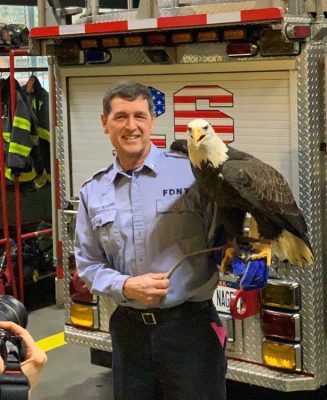
Charlie Roberto is a local legend in the environmental community, a straight-talking, retired New York City Fire Department captain who left firefighting in 2019 after four decades on the job.
An avid Teatown preserve volunteer, he was hailed in a 2008 local magazine headline as the “Birdman of Ossining,” to capture his passion.
The naturalist said Croton Point Park has been mismanaged for years, leading to the domination of invasive species such as mugwort.
“I consider the grassland the field of dreams, and if you build it, they will come,” the eminently quotable Roberto remarked. “It’s probably the best habitat in the whole county for grassland nesting birds. The mugwort invasion has been detrimental to bird populations, and we need to invest in long-term maintenance to save these habitats.”
Roberto explained how the restoration project began in the 1990s, with past success in attracting a variety of bird species. However, the area has seen a decline in bird numbers due to the unchecked spread of invasives.
“Croton Point Park is an important stopover for migrating birds on the eastern flyway,” he said. “If we don’t address some of these issues now, they get to the point where they’re not manageable. We’re losing our native trees, and it’s crucial to act to preserve our natural environment.”
I asked him why he believes the neglect has persisted.
“One guy who was oversight for the project retired, and I think he just wanted to be done with it and retire,” Roberto replied in our phone interview last week, seeming to echo Swaim’s sentiments.
I also wondered whether he’d previously emailed county officials to bring the issue to their attention. He then showed me a message he sent to a county conservation official on Oct. 12 of last year.
“This area by the Croton Bay was supposed to be mowed [at] the end of August or early September before the mugwort went to seed,” Roberto wrote in his plea to the official. “It still isn’t mowed and the seed is going to blow across to the treated grasslands. How do we get it mowed asap to limit the spread by wind?”
Crickets.
Solutions
I asked Roberto for proposed solutions and he suggested a stewardship team within the county parks department to focus on addressing invasive species and preserving the area’s natural habitat.
He pointed out how Teatown, a local Ossining-based nature reserve, employs a dedicated stewardship team of three or four people to maintain its 1,000-acre area. In comparison, the county parks, which covers more than 18,000 acres, lack a similar comprehensive stewardship program, Roberto said.
Such a team, consisting of several employees, would need to be funded annually to ensure effective management.
The county could probably achieve enormous results by investing a couple hundred thousand dollars per year at most in personnel. In fact, there would be cost-savings in the investment, Roberto maintained.
“It would save a lot of the trees in the county parks, and I don’t think you can solve the problem, but the parks would be a lot better,” he said. “You save a lot of money on lost trees or replanting trees.”
Although Roberto pointed out how Latimer has restored considerable funding cut during Republican Rob Astorino’s administration, the money needs to be more wisely invested, he said.
Projects like Croton Point restoration are framed by county officials as three-year initiatives. But there needs to be an ongoing, enduring commitment of sufficient personnel and planning, Roberto remarked.
“When they do these projects, they need to invest money long-term in it,” he said.
There are also safety risks if the county accepts the status quo.
He cited examples such as flooding but also a dramatic incident from three decades ago, when a tree fell on the Saw Mill River Parkway, causing one death.
“And the reason why the tree came down is because of all the vines going up the trees, and they went and then they cleared a lot of trees after that, but they probably had to pay on a lawsuit and everything like that,” Roberto said. “And if somebody had maintained that so these trees weren’t killed by the vines, that wouldn’t have happened.”
As recently as this past Saturday, absent sufficient county maintenance, Roberto has taken action himself, pulling mile-a-minute invasive plants. He’s pulled at least 34 this year.
Back to Borgia
Legislator Borgia (who knows Roberto well) stressed how she had to research the matter further before agreeing with his recommendation of a robust stewardship program.
“Park staff is something that we almost always talk about every budget season,” she said.
In our phone interview last week, Borgia initially wondered whether there might be a sizable volume of open positions in maintenance. But she investigated that possibility and found there are not “excessive vacancies.”
She also learned that County Director of Energy & Sustainability, Peter McCartt, is “aware of the maintenance needs of the grasslands and is addressing them.”
“[The Board of Legislators], and in particular me, since it’s my district, will ask for regular updates,” Borgia said.
The lawmaker also observed how during the pandemic there was a significant increase in park usage, making it even more crucial to ensure proper maintenance and preservation of natural habitats.
In terms of the critique on public engagement, Borgia said she receives considerable feedback from residents regarding park issues; she also noted how budget hearings offer opportunities for the public to express their concerns and suggestions.
But she said she’d examine the public information practices of Fairfax County to learn more.
“So I’m curious to look at this Fairfax, Virginia website to see how they do it differently, because it doesn’t feel like to me that there’s a lack of communication,” Borgia said.
Last Word
From my vantage point, there are clearly no sinister bad guys in this chapter of one local environmental tale.
“This government has been energetic in protecting our environment in a myriad of ways; as you have concerns about this specific matter, we will address that as well,” Latimer wrote in his email to Wallace. “As you can appreciate we get hundreds of e-mails every day, on a thousand topics, each one of the highest importance to the author who contacts us.”
From Latimer on down, there does not appear to be anyone involved without genuine interest and considerable engagement in the broader environmental issues at hand.
But Mother Nature doesn’t care.
She doesn’t pause for communication snafus, jurisdictional disputes, or bureaucratic breakdowns.
The damage is being done as we speak, despite best intentions, and even as plans are developed to address the problems.
As for Wallace, he stressed how this Croton Point Park ecological issue is part of a larger story.
He said endangered butterflies, bees, and other pollinators, not to mention birds such as Bobolinks, Eastern Meadowlarks, Short-eared Owls and Northern Harriers, all depend on the site for nesting, food, and shelter.
“With grasslands vanishing across New York State and the country,” Wallace said, “the hill has become a haven.”
Let’s hope his use of the present tense proves prophetic.

Adam has worked in the local news industry for the past two decades in Westchester County and the broader Hudson Valley. Read more from Adam’s author bio here.

